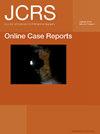Management of late in-the-bag IOL dislocation with exchange and scleral fixation of IOL with the transfixion technique
Q4 Medicine
引用次数: 0
Abstract
Introduction: Late in-the-bag intraocular lens (IOL) dislocation is a serious complication of cataract surgery. Patient and clinical findings: A 70-year-old woman with a history of left eye cataract surgery presented with progressively decreasing vision that had worsened over the past 6 months. In the left eye, the uncorrected distance visual acuity (UDVA) was counting fingers at 5 m, the corrected distance visual acuity (CDVA) was 20/25 (+12.25 −1.25 × 180), and the intraocular pressure was normal. An anterior segment examination revealed severe inferior dislocation of the IOL-capsular bag complex. Diagnosis, intervention, and outcomes: The patient was diagnosed with late in-the-bag IOL dislocation and underwent IOL–capsular bag complex explantation with sulcus-sutured IOL implantation using a new scleral fixation technique that included transfixion of a foldable acrylic IOL with polytetrafluoroethylene suture. The postoperative outcome was good; the UDVA was 20/70, and the CDVA was 20/25, and there were no postoperative complications such as infection, suture erosion, iritis, uveitis, vitreous hemorrhage, or retinal detachment. Conclusions: Late in-the-bag IOL dislocation was safely managed with IOL–capsular bag complex explantation and scleral fixation of a foldable posterior chamber IOL. This transfixion technique can be used for scleral fixation in patients with late in-the-bag IOL dislocation.人工晶状体置换巩膜固定术治疗晚期囊内人工晶状体脱位
引言:晚期囊内人工晶状体脱位是白内障手术的一个严重并发症。患者和临床发现:一名有左眼白内障手术史的70岁女性,视力逐渐下降,在过去6个月内恶化。左眼裸眼远视敏锐度(UDVA)为5米处数指,校正远视敏度(CDVA)为20/25(+12.25−1.25×180),眼压正常。眼前节检查显示IOL囊袋复合体严重下脱位。诊断、干预和结果:患者被诊断为晚期囊内IOL脱位,并使用一种新的巩膜固定技术,包括用聚四氟乙烯缝线刺穿可折叠丙烯酸IOL,接受了IOL-囊袋复合物移植和沟缝合IOL植入。术后效果良好;UDVA为20/70,CDVA为20/25,术后无感染、缝线侵蚀、虹膜炎、葡萄膜炎、玻璃体出血或视网膜脱离等并发症。结论:晚期囊内IOL脱位可通过人工晶状体-囊袋复合体移植和可折叠后房型IOL巩膜固定术安全治疗。这种穿刺技术可用于晚期囊内IOL脱位患者的巩膜固定。
本文章由计算机程序翻译,如有差异,请以英文原文为准。
求助全文
约1分钟内获得全文
求助全文

 求助内容:
求助内容: 应助结果提醒方式:
应助结果提醒方式:


